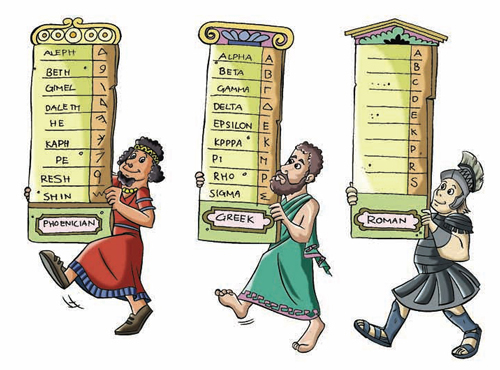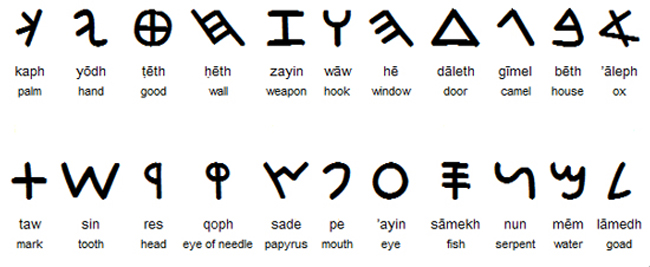palaeo-, palae-, paleo-, pale-
(Greek: original, ancient, primitive, old)
The arrangement and appearance of printed letters or ancient printing: The evolution of three paleontypographies or classical languages; including, Phoenician, Greek, and Roman.



The Phoenician alphabet was perhaps the first alphabetic script to be widely-used because the Phoenicians traded around the geographical area of the Mediterranean and beyond while they established cities and colonies in parts of southern Europe and North Africa.
The origins of most alphabetic writing systems can be traced back to the Phoenician alphabet, including Greek, Etruscan, Latin, Arabic and Hebrew; as well as the scripts of India and East Asia.
Significant Features
- Direction of writing is from the right to the left in horizontal lines: aleph to tow; as shown in the chart below.
- The writing system is abjad, a consonant alphabet with no indication of vowels.
- The number of letters is twenty-two; however, there were variations in their forms in different regions and at different times.
- The names of the letters are acrophonic, relating to the use of symbols to represent sounds, and their names and shapes can be traced back to Egyptian Hieroglyphs; for example, the name of the first letter, aleph, means ox which was developed from a picture of an ox's head.
- Some of the letter names were changed by the Phoenicians, including gimel, which meant camel in Phoenician, but was originally a picture of a throwing stick or a giml.
Here are the Phoenician symbols or letters.

Click on this Greek and Related Roman Alphabets page for more information.
paleo-ornithology
The study of birds which existed in ancient times
paleophis, palaeophis
A genus of extinct Ophidians containing the oldest known fossil serpents.
An immoderate hostility about the past: Mr. and Mrs. Conner didn't like to have any old things from their ancestors in their home because they only wanted to have contemporary furniture and modern art, and it became so irrational that they were thought to have paleophobia!
paleophobic (adjective), more paleophobic, most paleophobic
Referring to someone who detests old things: Susan was certainly paleophobic because she threw away anything that was antiquated or old-fashioned because she was afraid that the items would become ragged and shabby, although they were in perfect shape!
paleophytic
paleopsychic
A reference to the assumed (prehistoric) origins of behavior patterns in humans.
paleopsychology
paleoseismology, paleoseismologic, paleoseismological
The detailed study of landforms across fault zones, analysis of deformed layers of sediment in the walls of trenches excavated across active faults and the determination of the age of carbonaceous material found in the sediments, using radiometric techniques. Specialists have gone back into earthquake history, not in terms of years or decades, but in terms of centuries to arrive at long-term patterns.
paleotechnic
paleothere
paleothermometry
The investigation of the temperature of climates and oceans in past ages.
Paleozoic, Palaeozoic (adjective), more Paleozoic, most Paleozoic
Relating to the geologic era extending from the end of the Precambrian to the beginning of the Mesozoic: The Paleozoic period, formally termed "Primary", dates from about 542 to 250 million years ago, from the era of trilobites to those of the reptiles.
The study of the distribution of fossil animal remains: Janet studied paleobiogeography and wanted to specialize in paleozoogeography, which dealt with the dispersion or of animals in past geologic times.
A subdivision of paleontology that is the study of fossil animals: Mandy was certainly interested in petrified remains of the geological past and decided to specialize in paleozoology and learn more about prehistoric animals and their evolution.

